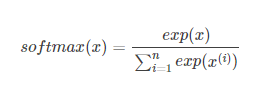实现Softmax 。本以为十分简单,不想还是遇到了各种问题。
最终的程序如下,如果还有问题再做修正。
def softmax(x):
orig_shape = x.shape
if len(x.shape) > 1:
# Matrix
x=np.exp(x-np.max(x,1).reshape(-1,1))/np.sum(np.exp(x-np.max(x,1).reshape(-1,1)),axis=1)
#raise NotImplementedError
else:
x=(np.exp(x-max(x)))/np.sum(np.exp(x-max(x)))
# Vector
#raise NotImplementedError
assert x.shape == orig_shape
return x
提供了三个样例进行检验。
def test_softmax_basic():
"""
Some simple tests to get you started.
Warning: these are not exhaustive.
"""
print ("Running basic tests...")
test1 = softmax(np.array([1,2]))
print (test1)
ans1 = np.array([0.26894142, 0.73105858])
assert np.allclose(test1, ans1, rtol=1e-05, atol=1e-06)
test2 = softmax(np.array([[1001,1002],[3,4]]))
print (test2)
ans2 = np.array([
[0.26894142, 0.73105858],
[0.26894142, 0.73105858]])
assert np.allclose(test2, ans2, rtol=1e-05, atol=1e-06)
test3 = softmax(np.array([[-1001,-1002]]))
print (test3)
ans3 = np.array([0.73105858, 0.26894142])
assert np.allclose(test3, ans3, rtol=1e-05, atol=1e-06)
print ("You should be able to verify these results by hand!\n")
softmax函数公式如下

起初单纯的按照公式来实现。第一个样例没有问题,第二个样例就出现了问题。因为exp函数的输入过大,出现了inf。第一反应是去调整精度(错误做法)。正确做法如下:

换算后可以正常使用。
(这里多亏了https://blog.youkuaiyun.com/linuxwindowsios/article/details/78003312)
之后的问题是如何实现上述变换。在矩阵的情况下进行实现遇到了问题。
1.如何求出矩阵每行/每列的最大值。
>>>np.max(x,0) #计算所有列的最大值
>>>np.max(x,1) #计算所有行的最大值
2.求得的最大值是一个一维向量。需要进行转置。一维向量无法使用.T。使用reshape函数。
>>> a = np.array([1, 2, 3])
>>> a = a.reshape(-1, 1)
>>> a
array([[1],
[2],
[3]])
3.sum函数的使用
当axis为0时,是压缩行,即将每一列的元素相加,将矩阵压缩为一行
当axis为1时,是压缩列,即将每一行的元素相加,将矩阵压缩为一列
>>> np.sum([[0, 1], [0, 5]], axis=0)
array([0, 6])
>>> np.sum([[0, 1], [0, 5]], axis=1)
array([1, 5])
4.作业中的raise NotImplementedError 一度困扰我。注释掉后程序就没有问题。







 本文详细介绍了Softmax函数的实现过程,包括如何避免数值稳定性问题,如处理exp函数的大输入导致的inf问题。通过具体示例展示了如何在向量和矩阵中正确应用Softmax函数,并提供了一个可运行的Python代码实现。
本文详细介绍了Softmax函数的实现过程,包括如何避免数值稳定性问题,如处理exp函数的大输入导致的inf问题。通过具体示例展示了如何在向量和矩阵中正确应用Softmax函数,并提供了一个可运行的Python代码实现。
















 504
504

 被折叠的 条评论
为什么被折叠?
被折叠的 条评论
为什么被折叠?








